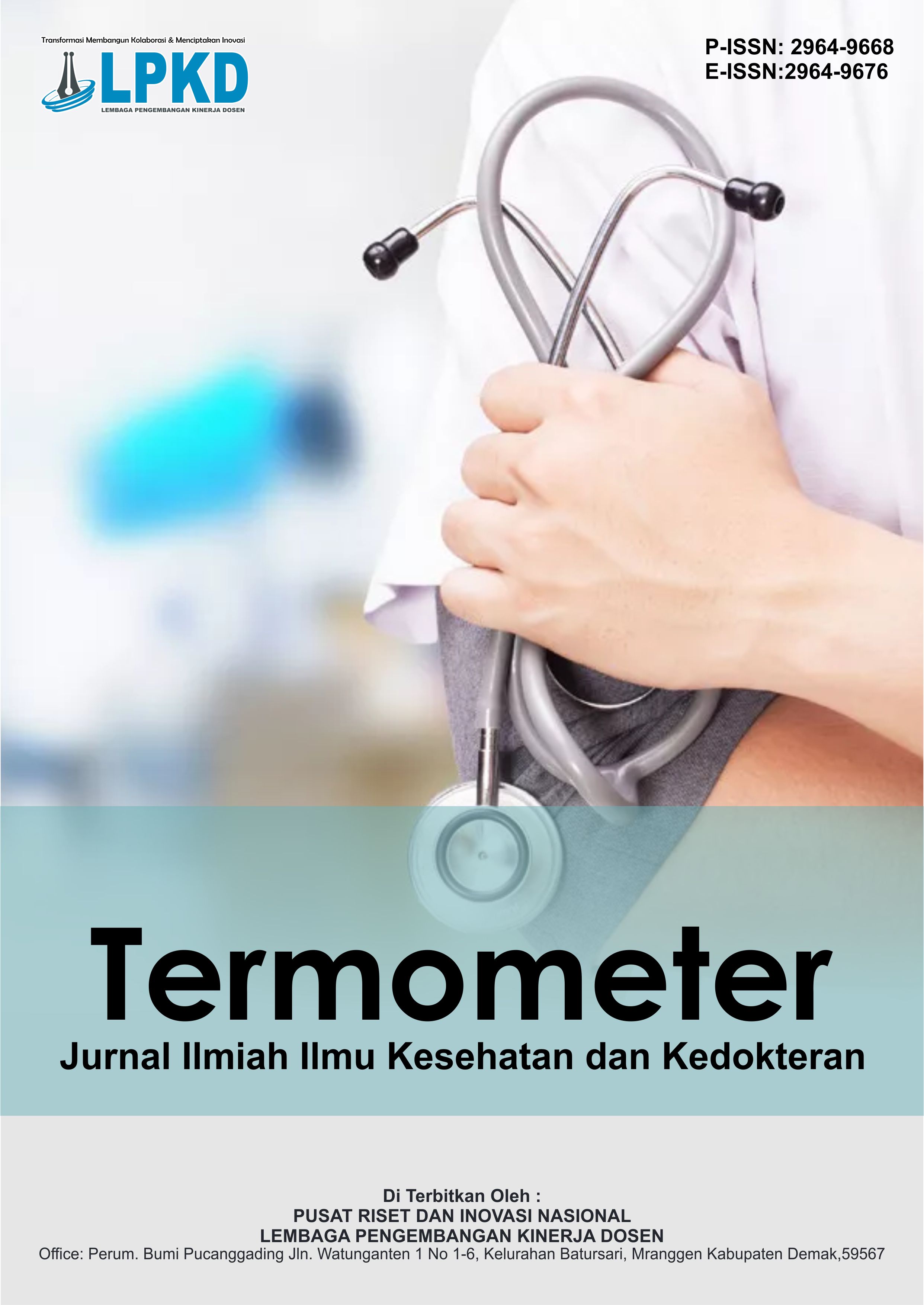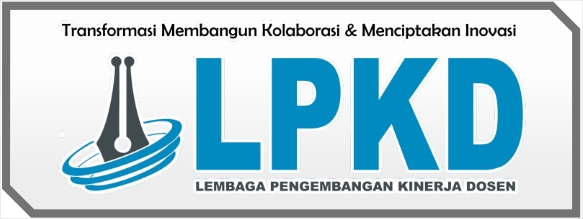Faktor-faktor yang Berhubungan dengan Kejadian Systemic Inflammatory Response Syndrome pada Pasien Hemodialisis
DOI:
https://doi.org/10.55606/termometer.v2i4.4333Keywords:
Chronic Kidney Failure, Hemodialysis, Systemic Inflammatory Response Syndrome.Abstract
Background: Chronic kidney failure (CKD) is a condition of decreased kidney function for more than three months. Patients of CKD require renal replacement therapy by hemodialysis. Patients of hemodialysis often associated with Systemic Inflammatory Response Syndrome (SIRS) incidence and infection is one of the risks. Infection can develop into a dangerous event, namely sepsis. In Indonesia there were 433 cases of sepsis lead to death in hemodialysis patients. This study aims to analyze the risk facotrs that cause SIRS incidence in RS Roemani Muhammadiyah Semarang. Method: This was an observational analytic study with cross sectional design. Vascular access, age, sex, nutritional status, diabetes mellitus, hypoalbuminemia, anemia as independent variable and SIRS incidence as dependent variable. The subject in this study were all patients with a diagnosis of CKD who undergo hemodialysis treatment. This study was carried out in RS Roemani Muhammadiyah Semarang. The sampling was taken by total sampling through medical record data sources during the period January 2017 until December 20121. Statistical analysis used the Chi-Square Test for bivariat analysis and logistic regression test for multivariate.Result: Total sample obtained 46 samples. Result of bivariate test indicate that the vascular access (p=0,012); age (p=0,245); sex (p=0,332); nutritional status (p=0,457); diabetes mellitus (p=0,013); hypoalbuminemia (p=0,009); anemia (p=0,049). The Results of multivariate are known to have a strong influence on the incidence of SIRS are diabetes mellitus (p=0,035, OR=14,360) dan hypoalbuminemia (p=0,021, OR=10,167).Conclusion: There were significant correlation between vascular access, diabetes mellitus, hypoalbuminemia, anemia and SIRS incidence on hemodialysis patients. The Results of multivariate analysis showed that diabetes mellitus and hypoalbuminemia is very influential with SIRS incidence on hemodialysis patients in RS Roemani Muhammadiyah Semarang.
Downloads
References
Alwarawah, Y., & Kieman, K. M. N. (2018). Changes in nutritional status impact immune cell metabolism and function. Frontiers in Immunology, 9, 1055. https://doi.org/10.3389/fimmu.2018.01055
Balk, R. A. (2014). Systemic inflammatory response syndrome (SIRS): Where did it come from and is it still relevant today? Virulence, 5(1), 20–26. https://doi.org/10.4161/viru.27468
Basri, N. S., & Patrianef, P. (2017). Infection of double lumen catheter as hemodialysis access. New Ropanasuri Journal of Surgery, 2(1), 25–28. http://www.nrjs.ui.ac.id/index.php/journal/article/view/18/22
Gorriz, J. L., & Martinez-Castelao, A. (2012). Proteinuria: Detection and role in native renal disease progression. Transplantation Reviews, 26, 3–13. https://doi.org/10.1016/j.trre.2012.01.001
Hadian, B., Zafarmohtashami, A., & Razani, M. (2020). Catheter-related bloodstream infections in hemodialysis patients. Journal of Renal Injury Prevention, 9(4), 1–7. https://doi.org/10.34172/jrip.2020.03
Iqbal, M., Rustam, R., & Rivaldy, V. (2021). Risk factors of catheter-related infection in patients undergoing hemodialysis using double lumen catheter at Dr. M. Djamil Hospital Padang. Bioscience Medicine: Journal of Biomedical and Translational Research, 6(1), 1292–1299. https://doi.org/10.32539/bm.v6i1.786
Knežević, V., Mirković, T. D., Božić, D., Majstorović, G. S., Mitić, I., & Gvozdenović, L. (2018). Faktori rizika od nastanka infekcija povezanih sa kateterom kod bolesnika na hemodijalizi. Vojnosanitetski Pregled, 75(2), 159–166. https://doi.org/10.2298/VSP150831062K
Lok, C. E., Huber, T. S., Lee, T., Shenoy, S., Yevzlin, A. S., Abreo, K., et al. (2019). KDOQI clinical practice guideline for vascular access: 2019 update.
Lyu, B., Chan, M. R., Yevzlin, A. S., Gardezi, A., & Astor, B. C. (2022). Arteriovenous access type and risk of mortality, hospitalization, and sepsis among elderly hemodialysis patients: A target trial emulation approach. American Journal of Kidney Diseases, 79(1), 69–78. https://doi.org/10.1053/j.ajkd.2021.03.030
MacRae, J. M., Dipchand, C., Oliver, M., Moist, L., Yilmaz, S., Lok, C., et al. (2016). Arteriovenous access: Infection, neuropathy, and other complications. Canadian Journal of Kidney Health and Disease, 3(1).
Mohamed, H., Ali, A., Browne, L. D., O’Connell, N. H., Casserly, L., Stack, A. G., et al. (2019). Determinants and outcomes of access-related bloodstream infections among Irish haemodialysis patients: A cohort study. BMC Nephrology, 20(1), 1–9. https://doi.org/10.1186/s12882-019-1457-8
Samani, S., Saffari, M., Merat, E., & Khaki, A. (2015). Bloodstream infection among patients on hemodialysis by arteriovenous fistula and graft. Comp Clin Path, 24(2), 291–294. https://doi.org/10.1007/s00580-014-1855-8
Sebayang, A. N. O. (2020). Arteriovenous shunt sebagai akses hemodialisis pada pasien gagal ginjal kronis. Jurnal Medika Klinik Indonesia, 8(2), 111–116.
Semadi, N., & Raka Widiana, G. (2015). Faktor risiko infeksi kateter hemodialisis double lumen non-tunneled. Jurnal Kedokteran, 46, 1–20.
Sudiono, J. (2014). Sistem kekebalan tubuh. Jakarta: Buku Kedokteran EGC.
Swenson, E. R., Porcher, R., & Piagnerelli, M. (2018). Iron deficiency and infection: Another pathway to explore in critically ill patients? Intensive Care Medicine, 44(12), 2260–2262. https://doi.org/10.1007/s00134-018-5438-8
Tordoir, J. H. M. (2010). Vascular access for dialytic therapies. In Comprehensive clinical nephrology (pp. 1031–1042). Elsevier Inc.
Widani, N. L. H. S. (2021). Faktor-faktor yang berhubungan dengan kejadian infeksi kateter double lumen pada pasien gagal ginjal kronik dengan hemodialisis di RS X Jakarta. Jurnal Kesehatan, 3(3), 497–498.
Downloads
Published
How to Cite
Issue
Section
License
Copyright (c) 2024 Termometer: Jurnal Ilmiah Ilmu Kesehatan dan Kedokteran

This work is licensed under a Creative Commons Attribution-ShareAlike 4.0 International License.










